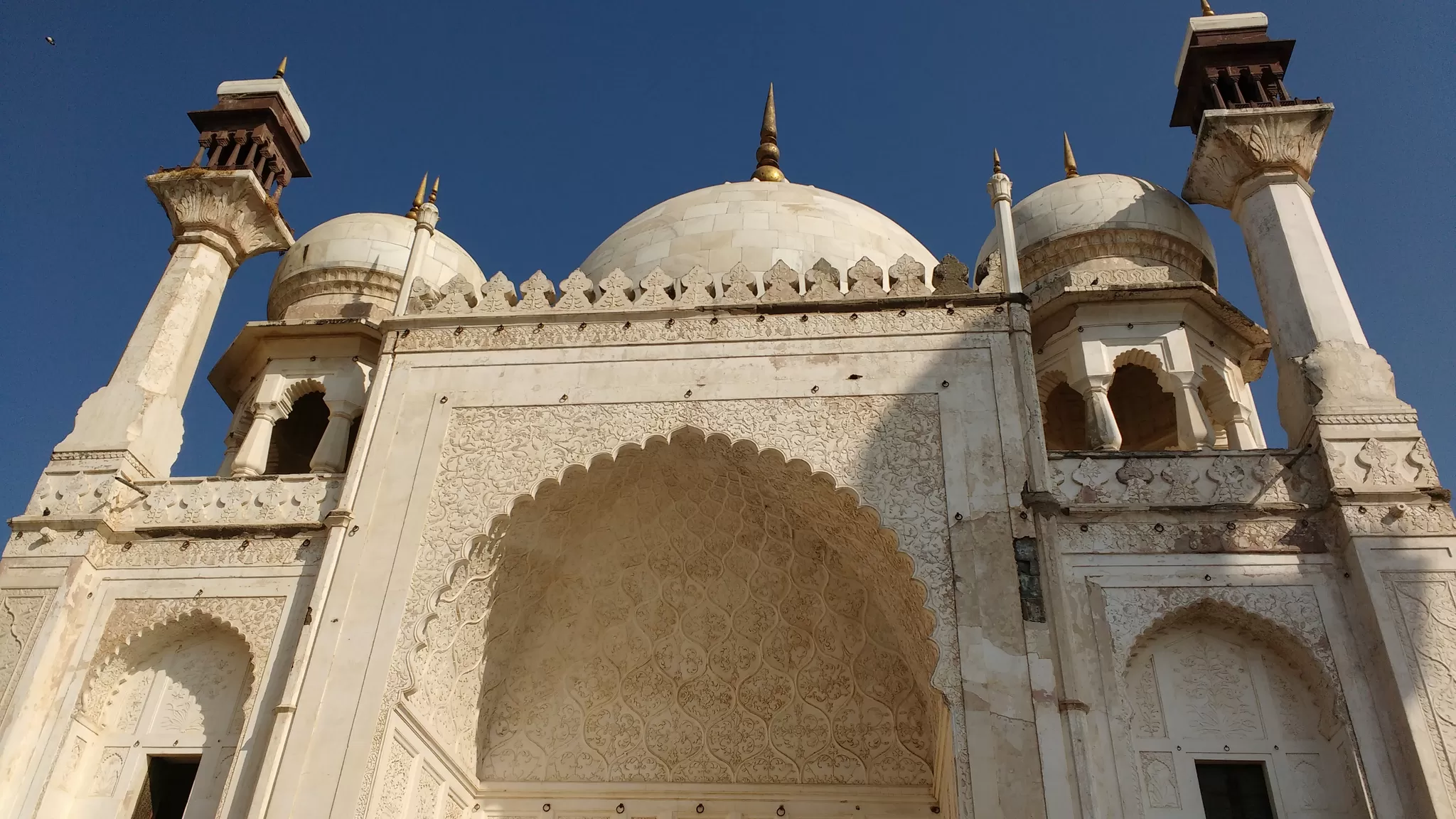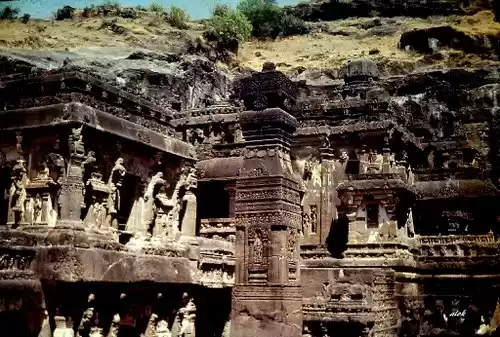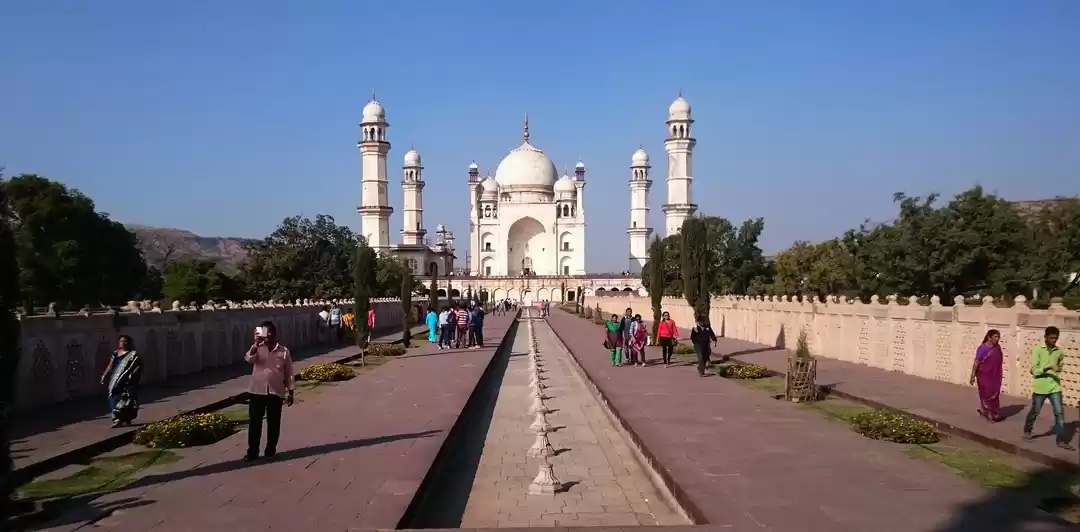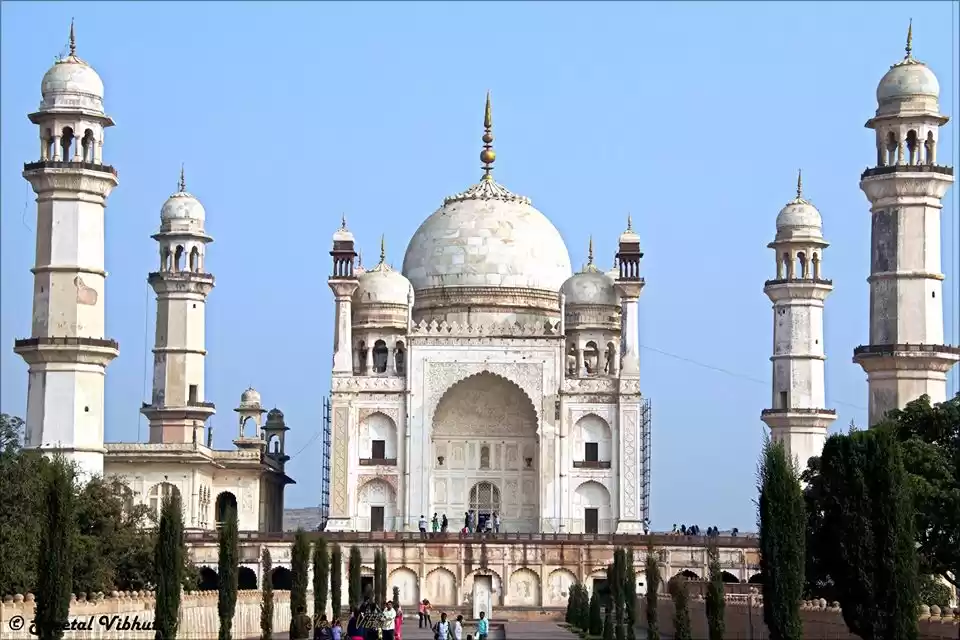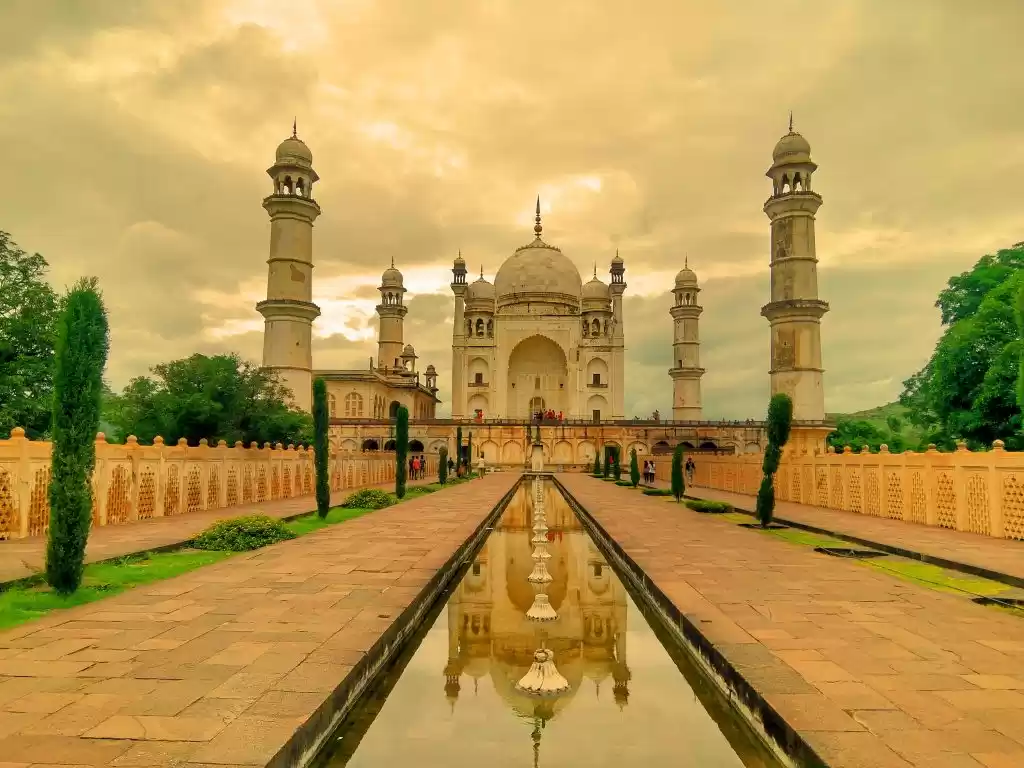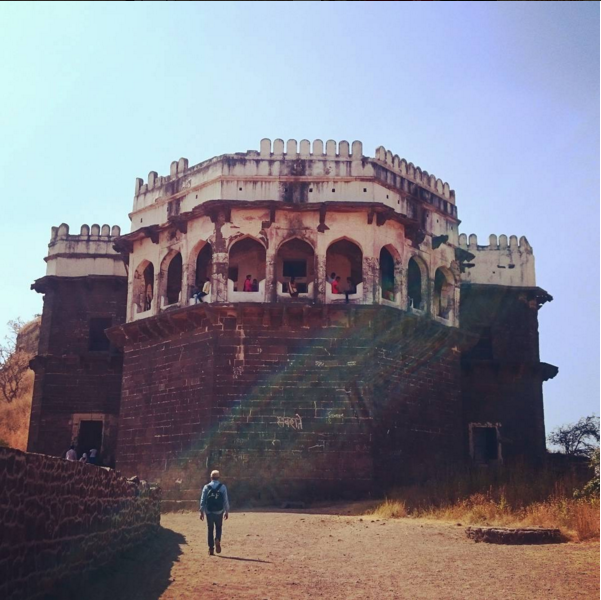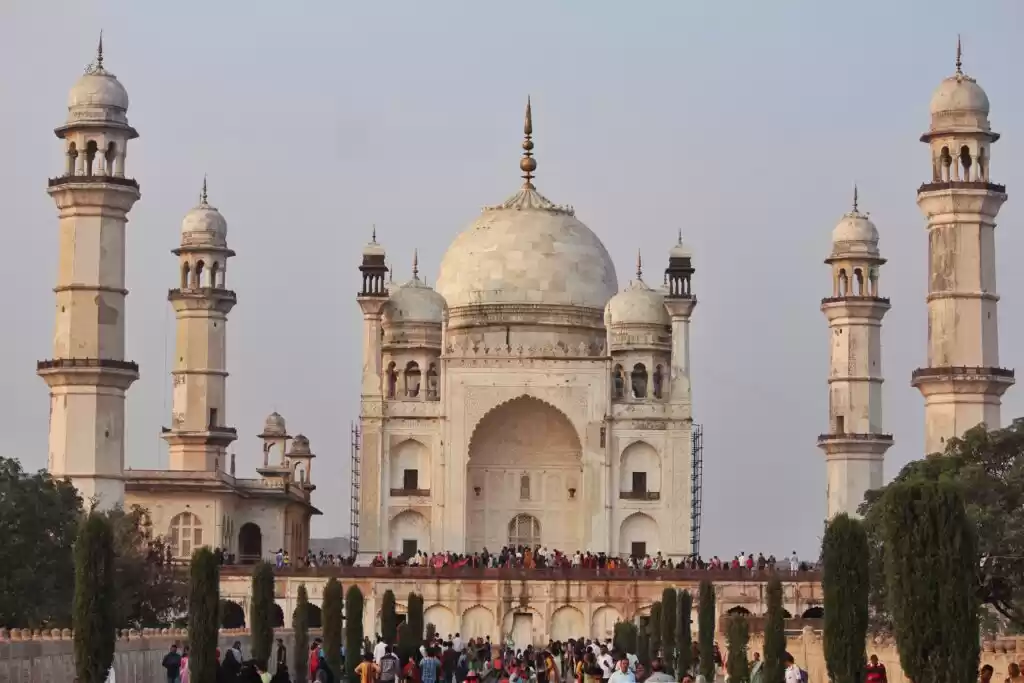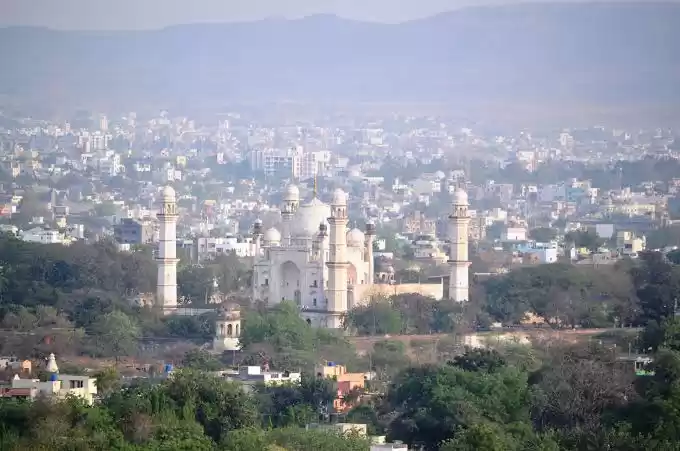Have you ever wondered if there is another monument in India that resembles the Taj Mahal? If yes, then you are in for a treat. Bibi ka Maqbara, which literally means “the tomb of the lady”, is a magnificent mausoleum located in Aurangabad, Maharashtra. It was built by the Mughal emperor Aurangzeb for his beloved wife Dilras Banu Begum, who died in 1657.
Bibi ka Maqbara is often called the “replica of Taj Mahal” or the “poor man’s Taj Mahal” because of its striking similarity to the iconic monument in Agra. However, Bibi ka Maqbara has its own charm and beauty that make it a must-visit destination for history and culture lovers. In this article, we will explore the history and architecture of Bibi ka Maqbara, its culture and religion, its tourism and entertainment options, and how to plan a trip to this amazing place.
History and Architecture of Bibi ka Maqbara
Bibi ka Maqbara was commissioned by Aurangzeb in 1660 as a tribute to his wife Dilras Banu Begum, who was also known as Rabia-ud-Daurani. She was his first and chief consort, and the mother of his successor Azam Shah. Aurangzeb loved her dearly and was deeply affected by her death. He decided to build a mausoleum for her that would rival the Taj Mahal, which was built by his father Shah Jahan for his wife Mumtaz Mahal.
The construction of Bibi ka Maqbara took about 10 years and cost about 7 lakh rupees. Aurangzeb appointed his son Azam Shah as the chief patron of the project, and hired an architect named Ata-ullah, who was the son of Ustad Ahmad Lahauri, the chief architect of the Taj Mahal. Ata-ullah designed Bibi ka Maqbara in a similar style and layout as the Taj Mahal, using marble and red sandstone as the main materials. However, due to Aurangzeb’s austerity measures and lack of funds, the quality and quantity of marble used in Bibi ka Maqbara was much less than that of the Taj Mahal. Moreover, Aurangzeb did not allow any precious stones or gold to be used in the decoration of Bibi ka Maqbara, unlike the Taj Mahal.
Bibi ka Maqbara consists of a main building that houses the tomb of Dilras Banu Begum, surrounded by four minarets at each corner. The main building has a large dome on top, which is flanked by four smaller domes. The dome is made of marble, while the rest of the building is made of red sandstone with marble panels. The main building is set on a high platform that has a hexagonal screen around it. The platform is accessed by four staircases from each side. The main building also has a mosque on its west side, where visitors can offer prayers.
The main building is situated in the center of a large garden that has four water channels running through it. The garden is divided into four parts by these channels, representing the Islamic concept of paradise. The garden also has fountains, pavilions, and flower beds that add to its beauty and serenity. The garden is enclosed by a high wall that has three gates on each side. The main gate is on the south side, which faces the city of Aurangabad. The main gate is also made of red sandstone with marble panels and has an inscription that reads “This monument has been built by Azam Shah, son of Alamgir (Aurangzeb), in memory of his mother Rabia-ud-Daurani (Dilras Banu Begum) in 1090 AH (1679 AD)”.
Bibi ka Maqbara is a remarkable example of Mughal architecture that blends Persian and Indian elements. It showcases the skill and craftsmanship of the artisans who worked on it. It also reflects the love and devotion of Aurangzeb for his wife Dilras Banu Begum, who rests peacefully in this splendid mausoleum.
Culture and Religion of Bibi ka Maqbara
Bibi ka Maqbara is not only a historical monument but also a cultural and religious site that attracts visitors from different backgrounds and beliefs. Bibi ka Maqbara is a symbol of love and devotion between Aurangzeb and Dilras Banu Begum, who were devout Muslims and followers of the Sufi order.
They were known for their piety and charity, and were respected by their subjects and peers. Bibi ka Maqbara is also a symbol of the Mughal culture and heritage that flourished in India for more than three centuries. The Mughals were patrons of art, literature, music, and science, and contributed to the development and enrichment of the Indian civilization.
Bibi ka Maqbara is also a place of worship and spirituality for many visitors who come to pay their respects to Dilras Banu Begum and seek her blessings. There is a mosque near the mausoleum, where visitors can offer prayers and recite the Quran.
There is also a museum inside the mausoleum, where visitors can learn more about the history and culture of Aurangabad and the Mughal Empire. The museum displays various artifacts, paintings, coins, weapons, and documents that belong to the Mughal period. The museum also has a replica of the original tomb of Dilras Banu Begum, which is located in the basement of the mausoleum. The original tomb is not accessible to the public, as it is considered sacred by the locals.
Bibi ka Maqbara is a place where visitors can experience the beauty and diversity of the Indian culture and religion. It is a place where visitors can admire the architecture and art of the Mughals, appreciate the love and devotion of Aurangzeb and Dilras Banu Begum, and feel the peace and tranquility of the garden and the mosque.
Tourism and Entertainment at Bibi ka Maqbara
Bibi ka Maqbara is not only a place of history and culture but also a place of tourism and entertainment for visitors who want to have some fun and enjoyment. Bibi ka Maqbara offers various attractions and activities for different types of travelers, such as friends, family, and couples.

For those who love history and architecture, Bibi ka Maqbara is a perfect destination to witness the grandeur and elegance of the Mughal era. Visitors can explore the mausoleum and its surroundings, marvel at the intricate details and designs, compare it with the Taj Mahal, and learn more about its history and significance. Visitors can also visit some of the nearby monuments that are related to Bibi ka Maqbara, such as the Aurangabad Caves, Daulatabad Fort, Panchakki, Grishneshwar Temple, Chhatrapati Shivaji Museum, etc. These monuments are also examples of the rich and diverse heritage of Aurangabad and India.
For those who love nature and scenery, Bibi ka Maqbara is a wonderful destination to enjoy the beauty and serenity of the garden and the water channels. Visitors can take a stroll in the lush green lawns, admire the colorful flowers and plants, listen to the soothing sound of water flowing through the fountains, watch the birds flying in the sky, or relax under the shade of trees. Visitors can also take a boat ride in the pond near the mausoleum, which offers a stunning view of Bibi ka Maqbara from a different perspective.
For those who love photography and art, Bibi ka Maqbara is an ideal destination to capture some amazing pictures and videos. Visitors can take advantage of the natural light and scenery to create some beautiful shots of Bibi ka Maqbara from different angles and distances. Visitors can also use their creativity and imagination to create some artistic shots using filters, effects, or props. Visitors can also admire the art and craftsmanship of Bibi ka Maqbara by observing its carvings, paintings, calligraphy, etc.
For those who love shopping and souvenirs, Bibi ka Maqbara is a great destination to buy some local handicrafts and products. Visitors can find some shops near Bibi ka Maqbara that sell various items such as pottery, jewelry, carpets, shawls, paintings, etc. These items are made by local artisans using traditional techniques and materials. They reflect the culture and style of Aurangabad and India. Visitors can also bargain with the sellers to get a good deal on their purchases.
Bibi ka Maqbara is a place where visitors can have fun and entertainment according to their preferences and interests. It is a place where visitors can make some unforgettable memories with their loved ones.
Entry Fee
Tickets to Bibi Ka Maqbara cost:
Indian citizens: Rs 25
Foreign tourists: Rs 300
SAARC and BIMSTEC visitors: Rs 25
You can purchase tickets at the ticket counter or pre-book them online.
You Won’t Believe What Aurangabad Has to Offer: A 4-day guide to the historical gems of the Crown of Deccan.
How to Plan a Trip to Bibi ka Maqbara
If you are planning to visit Bibi ka Maqbara, here are some tips and suggestions that will help you make your trip smooth and enjoyable:

Book a cab:
The best way to reach Bibi ka Maqbara from Aurangabad or any other nearby city is by booking a cab service that will take you there comfortably and safely. You can choose from various options such as sedan, SUV, or tempo traveler according to your budget and group size. You can also book a round-trip package that will include the cab service, the entry fee, and the guide fee for Bibi ka Maqbara. You can book a cab service online or through a travel agent.
Choose the best time to visit:
The best time to visit Bibi ka Maqbara is between October and March, when the weather is pleasant and cool. The average temperature during this period is around 20°C, which is ideal for sightseeing and exploring. The monsoon season from June to September should be avoided, as it can cause heavy rainfall and flooding. The summer season from April to May should also be avoided, as it can be very hot and dry. The average temperature during this period can reach up to 40°C, which can be uncomfortable and exhausting.
Carry essential items:
You should carry some essential items with you when you visit Bibi ka Maqbara, such as:
Water and snacks: You should carry enough water and snacks with you to keep yourself hydrated and energized. You may not find many options for food and drinks near Bibi ka Maqbara, so it is better to be prepared.
Comfortable clothes and shoes: You should wear comfortable clothes and shoes that are suitable for the weather and the terrain. You may have to walk a lot or climb some stairs, so you should wear something that is easy and flexible. You should also avoid wearing anything that is too revealing or offensive, as Bibi ka Maqbara is a religious site and you should respect the local culture and customs.
Camera and accessories: You should carry a camera and some accessories with you to capture some amazing pictures and videos of Bibi ka Maqbara and its surroundings. You should also carry some extra batteries, memory cards, chargers, etc., in case you run out of power or storage. You should also be careful not to damage or lose your camera or accessories, as they may be expensive or irreplaceable.
Sunscreen and sunglasses: You should apply sunscreen and wear sunglasses to protect yourself from the sun’s rays and glare. You may spend a lot of time outdoors, so you should take care of your skin and eyes. You should also carry a hat or an umbrella to shield yourself from the heat or rain.
Hire a guide: You should hire a guide when you visit Bibi ka Maqbara, as they can provide you with more information and insights about the mausoleum and its history, architecture, culture, and religion. They can also answer your questions and clear your doubts about anything related to Bibi ka Maqbara. They can also help you navigate the site and avoid any hassles or troubles. You can hire a guide from the entrance gate of Bibi ka Maqbara or from your cab service provider.
Planning a trip to Aurangabad soon? Check out Do Ghumakkad’s 3-day trip to the wonders of Deccan and the replica of Taj Mahal!
Bibi ka Maqbara is a beautiful and fascinating place that deserves your attention and appreciation. It is a place where you can learn more about the Mughal era and its legacy, admire the love and devotion of Aurangzeb and Dilras Banu Begum, enjoy the beauty and serenity of the garden and the mosque, have fun and entertainment with your loved ones, and make some unforgettable memories.
If you are looking for a unique and memorable destination for your next trip, then you should definitely consider visiting Bibi ka Maqbara in Aurangabad.









